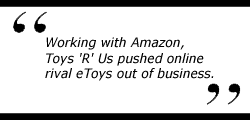Operations at the Core: What Amazon Offers Category Killers
Online's biggest retailer aims to serve the offline retailers it once threatened. The shift may be Amazon's best hope for prosperity.
ONLINE RETAILING CONTINUES its rapid and radical evolution. After the rise came the shakeout: eToys, once the number-two online retailer, reached a $9.4 billion market cap in October 1999, then dropped to a penny stock over the ensuing 18 months and ultimately shut down. Now, the number-one online retailer, Amazon, is openly seeking bricks-and-mortar alliances to add to its successful August 2000 partnership with Toys 'R' Us and its more recent deal with Borders Group.
What's behind this newest development? Retailers have recovered from their frenzied flight online and realized the Web will not make their physical assets obsolete. They view the online channel simply as a complementary alternative preferred by some customers, some of the time. No longer fearful, retail executives now are focusing on finding the most cost-effective ways to build a Web presence.
The Alliance Value Proposition
That consideration brings them to Amazon, which had planned to become "the earth's biggest store" and kill off other branded retailers in the process. Now, however, Amazon is using alliances to radically revamp that value proposition. It is positioning itself for the future as the "the earth's biggest mall," serving the very retailers it once threatened. Far from a capitulation, this represents a thoughtful strategic redirection — enhancing Amazon's odds of survival and perhaps leading it to true prosperity.

The deals can expand Amazon beyond its core BMV (books, music, and video) line into other consumer-products categories. For Amazon's strategy to work, it must find retail partners with products, demographics, and locations that fit with Amazon's strengths in technology, customer service, and logistics.
In that light, Toys 'R' Us and Amazon were made for each other. The leading toy retailer had severe problems in late 1999 fulfilling orders placed on Toysrus.com; for its part, Amazon could not find the right merchandise mix for toys, which, unlike BMV, must be bought far in advance of their sale and cannot be returned to manufacturers. Amazon's $39 million write-off of excess toy inventory after the 1999 holiday season highlights the challenges of toy merchandising. In 2000, however, the combination of merchandising and buying clout from Toys 'R' Us ($11.3 billion in fiscal 2000 sales vs. Amazon's $96.7 million in toy sales before the deal) with Amazon's 26 million customers proved formidable. Reinforced with a co-branded site, huge customer reach, and reliable logistics, Toysrus.com tripled its holiday 2000 sales over 1999 and had $180 million in sales for all of 2000. By working with Amazon, Toys 'R' Us pushed eToys, its only real online rival, out of business.
What might Amazon do next? A look at Amazon's home page provides clues to alliance possibilities. Beyond BMV, it has such product lines as electronics, health and beauty products, housewares, tools and hardware, and cars. Toys is the only category co-branded with a traditional, successful category killer. Amazon can burnish the other categories with partnerships that provide brand awareness, product expertise, and offline reach.

Finding the Best Partners
The best potential partners will be major players with wide product selection in discretionary spending categories. These category killers could leverage Amazon's Web site functionality — the ability to quickly suggest products based upon an understanding of the consumer's interests. The most appropriate products for Amazon's distribution center capabilities are smaller items that can be combined into a single box for shipping; large goods are best delivered by partners' local stores. Categories in which promising partnerships can be made include:
- Consumer Electronics. An electronics retailer has the products and stores, and Amazon has its unbranded electronics category. It's impractical for Amazon itself to ship bulky items (e.g., big-screen TVs), so a retailer with national locations would be an excellent partner. Local stores could distribute appliances and large consumer electronics sold on a co-branded site. Several national retailers could fill this role.
- Kitchen and Housewares. Kitchenware offers a nice fit for a category killer partnership given the huge array of gadgets marketed to wannabe chefs. Today, Amazon competes with several broad-based players offering kitchenware and two e-tailers focused exclusively on the category: Cooking.com and Chefscatalog.com, the online complement of Chef's, the leading catalog retailer of kitchenware. Williams-Sonoma clearly dominates the category's bricks-and-mortar channel, and could be a powerful co-branded partner.
- Tools and Hardware. Warehouse-style retailers The Home Depot and Lowe's compete to dominate this category offline. An Amazon deal could give more prominence to traditional retailer Ace Hardware, which has lost ground to these newer category killers.
Why Wal-Mart Won't Work
At first glance, many factors appear to favor a partnership between Wal-Mart and Amazon. And the press and market have responded favorably to rumors of a match-up. Clearly, Amazon would benefit from Wal-Mart's buying power, derived from sales of $191 billion — over 70 times more than Amazon's 2000 sales of $2.8 billion.
Despite this consideration, Wal-Mart would be a poor partner. First, the breadth of Wal-Mart's offering would add substantial complexity to Amazon's fulfillment operations. Second, Wal-Mart's scope would shut out the opportunity for Amazon to partner with other category killers. In fact, a Wal-Mart/Amazon relationship could conflict with the Toys 'R' Us partnership since Wal-Mart already sells more toys than does Toys 'R' Us!
A clash of basic cultures would likely present the biggest hurdle. Wal-Mart achieved its dominant global position by meticulously replicating a model fine-tuned by Sam Walton 40 years ago. Leveraging huge buying clout and unparalleled skill in low-cost logistics, Wal-Mart targets the price-conscious middle-class consumer seeking mainstream products. Amazon became the top online retailer through constant innovation in pursuit of a higher-end demographic — and stressing selection rather than price (since shipping charges clearly push up "competitive prices"). Though Amazon hired some high-profile operations executives from Wal-Mart, the infusion failed. The executives' systematic, deliberate mentality fared poorly in Amazon's dynamic culture.

Maintaining Momentum
Of course, striking an alliance with the right partner is not enough. After the deal, the partners have the hard work of keeping the relationship healthy. An online partnership, with few physical links, can be dissolved as quickly as it can be created. To sustain a position as the preferred online partner, Amazon will need to create innovative and appealing Web sites that reflect its partners' identities. If Amazon ceases to innovate, others can close the gap on its functionality lead — and potentially build a "mall" of equal quality. Likewise, if a partner doesn't maintain a strong offline presence, Amazon could switch to another category leader relatively easily.
While the Borders deal didn't put Amazon in new products, its success would further demonstrate Amazon's skills at running the core activities of online retailing: Web site development, customer service, and order fulfillment. By partnering with other retailers, Amazon can gain operational scale to lower costs and fund the continual innovation in site development that keeps customers coming back. Without the innovations that keep Amazon ahead of other online retailers, Amazon risks losing its preferential position with consumers.
In the end, the partnership logic is simple: Each player must maintain and continually build upon its core strengths. Amazon must continue to offer the best core operating assets in online retailing, and each category-killer partner must bring a strong offline presence and merchandising skill to serve the millions of customers who visit Amazon to fill their needs.
| Authors
Tim Laseter, lasetert@darden.virginia.edu, serves on the operations faculty at the Darden Graduate School of Business at the University of Virginia. Previously he was a a vice president with Booz Allen Hamilton in McLean, Va. Mr/ Laseter has 15 years of experience in building organizational capabilities in sourcing, supply chain management, and operations strategy in a variety of industries. Martha Turner, turner_martha@bah.com Martha Turner is a senior associate in Booz Allen Hamilton's New York office. She specializes in operations and supply chain management in a broad range of industries, with particular emphasis on e-business. |


